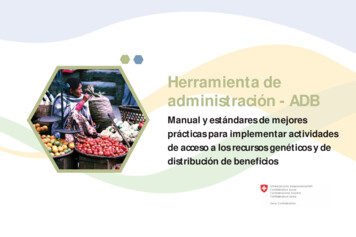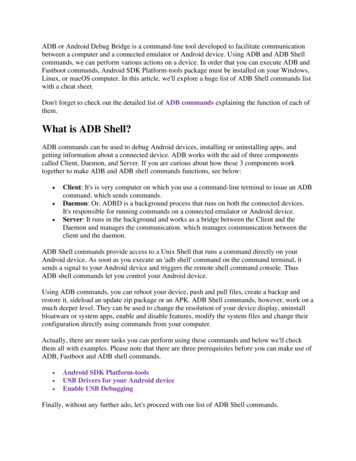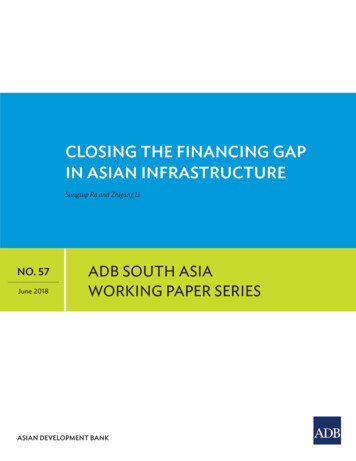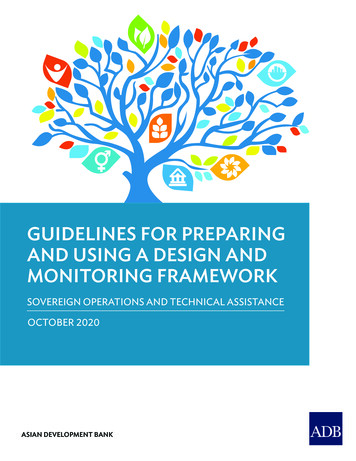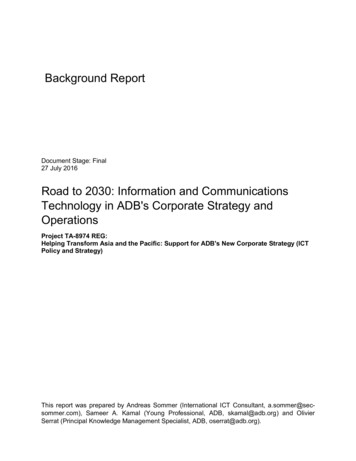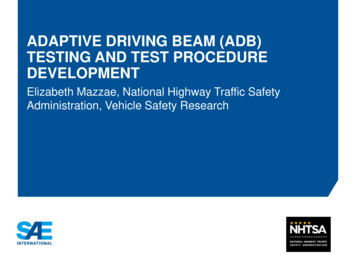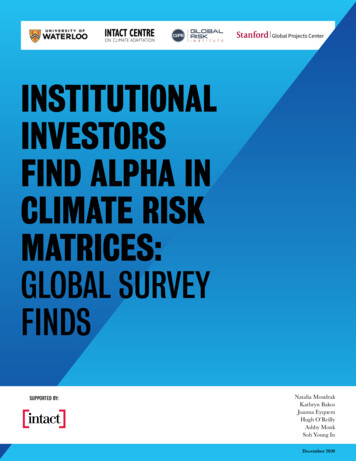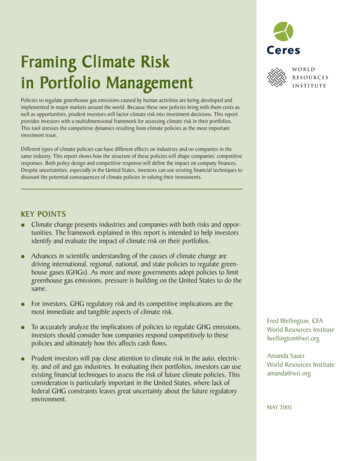
Transcription
4. Identification of Adaptation OptionsThe most viable adaptation options or climateproofing measures are identified in consultationwith the executing agencies or project sponsors,and are integrated in the project design. There is nostandardized approach to climate proofing. In somecases, climate proofing is essential to ensure the projectis not negatively affected by climate change. In othercases, the lifetime of the project is such that climateproofing is not a viable option or climate readiness isa more appropriate approach. Climate proofing mayinvolve adjusting engineering design such as increasingdrainage capacity of water supply systems, elevatingroads in areas particularly at risk from flooding, orecosystem-based adaptation measures such asrevegetation of unstable slopes.5. Monitoring and ReportingThe level of risk identified during project conceptdevelopment and the findings of climate risk andvulnerability assessment carried out during projectpreparation are documented in the ADB boarddocuments. A supplementary document describingResources Available to Support the Implementation of the ClimateRisk Management Framework in ADB Projectsthe assessment and adaptation measures incorporatedin the project design and associated costs can also beattached to the ADB board documents. The level ofrisk assigned to the project and the budget allocated toadaptation measures are recorded in the ADB projectclassification system for monitoring and reportingpurposes.ADB has made available technical and financial resources to supportthis framework: Technical resources are available to support climate risk screening andassessment in the Environment and Safeguards Division of the Regionaland Sustainable Development Department, which is ADB’s adaptationfocal point. Financial resources in the range of 4 million were made available throughADB’s Climate Change Fund at the beginning of 2014 to meet the costof carrying out climate risk and vulnerability assessments in projectscategorized as medium or high risk during initial screening. To support climate change adaptation investments, ADB has establisheddedicated trust funds in partnership with other development institutions.For example, the Urban Climate Change Resilience Trust Fund wasestablished with support from the United Kingdom’s Department forInternational Development, the Rockefeller Foundation, and the UnitedStates Agency for International Development. The fund is a 150 millionmulti-donor trust fund administered by ADB to scale up urban climateresilience across 25 medium-sized cities in Asia. ADB is also leveragingfinance from adaptation funds administered by the Global Environment Asian Development BankPublication Stock No. ARM146926-2November 2014Facility and the Climate Investment Funds. It has mobilized bilateralsources such as those from the Nordic Development Fund, and thegovernments of Australia, Canada, and Japan. ADB remains engaged tohelp countries access the Green Climate Fund, which is expected to comeonstream in 2015. ADB has developed tools, including the online tool AWARE for Projects,for consistent and systematic screening of climate risks. Technicalguidance materials are available to help project teams and developingmember countries manage climate risks throughout the project cycle,including climate-proofing guidance for the transport, agriculture, andenergy sectors. These are accessible through the ADB urces ).For more information, please contact:Cinzia Losenno,Climate Change Adaptation Focal PointAsian Development BankTel: (632) 632 4996E-mail: closenno@adb.orgCLIMATE RISK MANAGEMENTIN ADB PROJECTS
ADB’s Climate Risk ManagementFrameworkThe climate risk management approach of the AsianDevelopment Bank (ADB) aims to reduce risksresulting from climate change to investment projectsin Asia and the Pacific. ADB’s framework identifiesclimate change risks to project performance inthe early stages of project development, andincorporates adaptation measures in the designof projects at risk. ADB climate risk managementframework comprises the following steps:(i) context-sensitive climate risk screening at theconcept development stage to identify projectsthat may be at medium or high risk;(ii) climate change risk and vulnerability assessmentduring preparation of projects at risk;(iii) technical and economic evaluation ofadaptation options;(iv) identification of adaptation options in projectdesign; and(v) monitoring and reporting of the level of risk andclimate-proofing measures.Flow Chart for Climate Risk Management of Investment ProjectsProject Concept PhasePreliminary screening(checklist)ChecklistNo or low riskEndORMedium or high riskExpertjudgmentDetailed screening(Aware for projects or other detailed screening tool)Screening ReportNo or low riskMedium or high riskProject Preparation PhaseEndORExpertjudgmentClimate Risk and VulnerabilityAssessement (CRVA)Evaluation and selection of climate resiliencemeasures to include in project design;co-financing arrangementsCRVA ReportProject Implementation PhaseImplementation and monitoring of selectedclimate resilience measure(s)
ADB’s Climate Risk ManagementFrameworkThe climate risk management approach of the AsianDevelopment Bank (ADB) aims to reduce risksresulting from climate change to investment projectsin Asia and the Pacific. ADB’s framework identifiesclimate change risks to project performance inthe early stages of project development, andincorporates adaptation measures in the designof projects at risk. ADB climate risk managementframework comprises the following steps:(i) context-sensitive climate risk screening at theconcept development stage to identify projectsthat may be at medium or high risk;(ii) climate change risk and vulnerability assessmentduring preparation of projects at risk;(iii) technical and economic evaluation ofadaptation options;(iv) identification of adaptation options in projectdesign; and(v) monitoring and reporting of the level of risk andclimate-proofing measures.Flowchart for Assessing Climate Risk of ProjectsProject Concept PhasePreliminary screening(Rapid Environmental Assessment)ChecklistNo or low riskEndORMedium or high riskExpertjudgmentDetailed screening(AWARE for Projects or other tool)Screening ReportNo or low riskProject Preparation PhaseEndORMedium or high riskExpertjudgmentClimate Risk andVulnerability AssessmentCRVA ReportEvaluation of adaptation options;Project Implementation PhaseIntegration of climate risk reductionmeasures in project design1. Climate Risk ScreeningAll ADB projects are screened for climate risks. Aninitial screening is carried out by the project teamsby filling in a checklist. Projects identified to be atmedium or high risk undergo a further screeningthrough dedicated screening tools, such as the onlinetool AWARE for Projects. Risks considered are thoseresulting from temperature increase, precipitationchange, wind speed change, sea level rise, solarradiation change, water availability, flooding, tropicalstorms, wildfire, permafrost, sea ice, snow loading, andlandslide.2. Climate Risk and VulnerabilityAssessmentA detailed climate risk and vulnerability assessment iscarried out for projects classified as medium or highrisk during project preparation. The assessment aimsto quantify risks and identify adaptation options thatcan be integrated into the project design. The levelof technical rigor of the assessment depends on theproject complexity and availability of climate data andinformation for the project area. It can range from asimple desk analysis to a complex assessment based oncustom climate projections to enable a more detailedassessment.This assessment is usually conducted by experts withbackground in climate modeling, impact assessment,and economics of climate change who work togetherwith the ADB sector specialists, the executing agencies,the project sponsors, and other stakeholders toformulate adaptation solutions for the project.AWARE for ProjectsAWARE for Projects is an online tool used by ADB project teams to screenprojects for climate risks. The tool uses data from 16 general circulationmodels, as well as databases on temperature increase, wildfire, permafrost,sea ice, water availability, precipitation change, flooding, snow loading,tropical storms, and landslides. For each project screened, the toolgenerates an overall climate risk ranking of low, medium, or high; key riskareas; and narratives on potential impacts and adaptive measures to guidesubsequent activities.3. Technical and Economic Evaluationof Adaptation OptionsBased on the climate risk and vulnerabilities assessed,adaptation options are identified and evaluated onthe basis of their technical feasibility and economicviability. Technical feasibility evaluates whetherproposed engineering and nonengineering measurescan be implemented with available skills; equipment;and other local factors such as geography, governance,and capacity. The economic analysis involves estimatingand comparing the cost and benefits of the projectbased on two different scenarios: (i) the project underclimate change without adaptation measures, and(ii) the project under climate change with adaptationmeasures. It aims to identify which adaptation optionyields the highest net benefit. Recognizing that investingin adaptation measures may be costly and that futurebenefits may be uncertain, the economic analysis canalso point to the best timing for investing in adaptation.Climate Risk and Vulnerability Assessmentfor Central Mekong Delta RegionConnectivity ProjectThe project consists of two bridgesand an interconnecting road thatform part of a strategictransportation link connecting theprovinces of southern Viet Namand Ho Chi Minh City. Given theestimated high exposure of theMekong Delta to projected futureflooding, a climate risk andvulnerability assessment wasconducted for the project. Thestudy found that the embankmentsof the connecting road werevulnerable to the impacts of projected increases in the frequencyand intensity of upstream flooding. Projected impacts included(i) erosion of road embankments and scouring of roadfoundations, (ii) waterlogging of road foundations leading to roadsubsidence, (iii) reduced stability of infrastructure, and(iv) increased maintenance effort. As a result, a phased approachto climate change adaptation was adopted. During the first phase,the project design was adjusted by adding a 0.3-meter climatechange factor on road embankments to allow for expected higherfloods. For the second phase, adaptation will be considered as partof further maintenance and road upgrades and expansion.( Available at e-threat-vulnerability-assessment )
ADB’s Climate Risk ManagementFrameworkThe climate risk management approach of the AsianDevelopment Bank (ADB) aims to reduce risksresulting from climate change to investment projectsin Asia and the Pacific. ADB’s framework identifiesclimate change risks to project performance inthe early stages of project development, andincorporates adaptation measures in the designof projects at risk. ADB climate risk managementframework comprises the following steps:(i) context-sensitive climate risk screening at theconcept development stage to identify projectsthat may be at medium or high risk;(ii) climate change risk and vulnerability assessmentduring preparation of projects at risk;(iii) technical and economic evaluation ofadaptation options;(iv) identification of adaptation options in projectdesign; and(v) monitoring and reporting of the level of risk andclimate-proofing measures.Flowchart for Assessing Climate Risk of ProjectsProject Concept PhasePreliminary screening(Rapid Environmental Assessment)ChecklistNo or low riskEndORMedium or high riskExpertjudgmentDetailed screening(AWARE for Projects or other tool)Screening ReportNo or low riskProject Preparation PhaseEndORMedium or high riskExpertjudgmentClimate Risk andVulnerability AssessmentCRVA ReportEvaluation of adaptation options;Project Implementation PhaseIntegration of climate risk reductionmeasures in project design1. Climate Risk ScreeningAll ADB projects are screened for climate risks. Aninitial screening is carried out by the project teamsby filling in a checklist. Projects identified to be atmedium or high risk undergo a further screeningthrough dedicated screening tools, such as the onlinetool AWARE for Projects. Risks considered are thoseresulting from temperature increase, precipitationchange, wind speed change, sea level rise, solarradiation change, water availability, flooding, tropicalstorms, wildfire, permafrost, sea ice, snow loading, andlandslide.2. Climate Risk and VulnerabilityAssessmentThis assessment is usually conducted by experts withbackground in climate modeling, impact assessment,and economics of climate change who work togetherwith the ADB sector specialists, the executing agencies,the project sponsors, and other stakeholders toformulate adaptation solutions for the project.AWARE for ProjectsAWARE for Projects is an online tool used by ADB project teams to screenprojects for climate risks. The tool uses data from 16 general circulationmodels, as well as databases on temperature increase, wildfire, permafrost,sea ice, water availability, precipitation change, flooding, snow loading,tropical storms, and landslides. For each project screened, the toolgenerates an overall climate risk ranking of low, medium, or high; key riskareas; and narratives on potential impacts and adaptive measures to guidesubsequent activities.Final project risk ratingsHigh RiskA detailed climate risk and vulnerability assessment iscarried out for projects classified as medium or highrisk during project preparation. The assessment aimsto quantify risks and identify adaptation options thatcan be integrated into the project design. The levelof technical rigor of the assessment depends on theproject complexity and availability of climate data andinformation for the project area. It can range from asimple desk analysis to a complex assessment based oncustom climate projections to enable a more detailedassessment.Breakdown of risk topic ratingsA) Temperature increaseB) WildfireC) PermafrostD) Sea iceE) Precipitationi ncreaseF) FloodG) Snow loadingH) LandslideI) Precipitation decreaseJ) Watera vailabilityK) Wind speed increaseL) Onshore Category 1 stormsM) Offshore Category 1 stormsN) Wind speed decreaseO) Seal evel riseP) Solar radiation change3. Technical and Economic Evaluationof Adaptation OptionsBased on the climate risk and vulnerabilities assessed,adaptation options are identified and evaluated onthe basis of their technical feasibility and economicviability. Technical feasibility evaluates whether proposedengineering and nonengineering measures can beimplemented with available skills; equipment; and otherlocal factors such as geography, governance, and capacity.The economic analysis involves estimating and comparingthe cost and benefits of the project based on two differentscenarios: (i) the project under climate change withoutadaptation measures, and (ii) the project under climatechange with adaptation measures. It aims to identifywhich adaptation option yields the highest net benefit. Italso aims to estimate the incremental cost of adaptationas the cost of project activities aimed at addressingspecific climate vulnerabilities. Recognizing that investingin adaptation measures may be costly and that futurebenefits may be uncertain, the economic analysis can alsopoint to the best timing for investing in adaptation.Climate Risk and Vulnerability Assessmentfor Central Mekong Delta RegionConnectivity ProjectThe project consists of two bridgesand an interconnecting road thatform part of a strategictransportation link connecting theprovinces of southern Viet Namand Ho Chi Minh City. Given theestimated high exposure of theMekong Delta to projected futureflooding, a climate risk andvulnerability assessment wasconducted for the project. Thestudy found that the embankmentsof the connecting road werevulnerable to the impacts of projected increases in the frequencyand intensity of upstream flooding. Projected impacts included(i) erosion of road embankments and scouring of roadfoundations, (ii) waterlogging of road foundations leading to roadsubsidence, (iii) reduced stability of infrastructure, and(iv) increased maintenance effort. As a result, a phased approachto climate change adaptation was adopted. During the first phase,the project design was adjusted by adding a 0.3-meter climatechange factor on road embankments to allow for expected higherfloods. For the second phase, adaptation will be considered as partof further maintenance and road upgrades and expansion.( Available at e-threat-vulnerability-assessment )
4. Identification of Adaptation OptionsThe most viable adaptation options or climateproofing measures are identified in consultationwith the executing agencies or project sponsors,and are integrated in the project design. There is nostandardized approach to climate proofing. In somecases, climate proofing is essential to ensure the projectis not negatively affected by climate change. In othercases, the lifetime of the project is such that climateproofing is not a viable option or climate readiness isa more appropriate approach. Climate proofing mayinvolve adjusting engineering design such as increasingdrainage capacity of water supply systems, elevatingroads in areas particularly at risk from flooding, orecosystem-based adaptation measures such asrevegetation of unstable slopes.5. Monitoring and ReportingThe level of risk identified during project conceptdevelopment and the findings of climate risk andvulnerability assessment carried out during projectpreparation are documented in the ADB boarddocuments. A supplementary document describingResources Available to Support the Implementation of the ClimateRisk Management Framework in ADB Projectsthe assessment and adaptation measures incorporatedin the project design and associated costs can also beattached to the ADB board documents. The level ofrisk assigned to the project and the budget allocated tothe incremental cost of adaptation are recorded in theADB project classification system for monitoring andreporting purposes.ADB has made available technical and financial resources to supportthis framework: Technical resources are available to support climate risk screening andassessment in the Environment and Safeguards Division of the Regionaland Sustainable Development Department, which is ADB’s adaptationfocal point. Financial resources in the range of 4 million were made available throughADB’s Climate Change Fund at the beginning of 2014 to meet the costof carrying out climate risk and vulnerability assessments in projectscategorized as medium or high risk during initial screening. To support climate change adaptation investments, ADB has establisheddedicated trust funds in partnership with other development institutions.For example, the Urban Climate Change Resilience Trust Fund wasestablished with support from the United Kingdom’s Department forInternational Development, the Rockefeller Foundation, and the UnitedStates Agency for International Development. The fund is a 150 millionmulti-donor trust fund administered by ADB to scale up urban climateresilience across 25 medium-sized cities in Asia. ADB is also leveragingfinance from adaptation funds administered by the Global Environment Asian Development BankPublication Stock No. ARM146926-2November 2014Facility and the Climate Investment Funds. It has mobilized bilateralsources such as those from the Nordic Development Fund, and thegovernments of Australia, Canada, and Japan. ADB remains engaged tohelp countries access the Green Climate Fund, which is expected to comeonstream in 2015. ADB has developed tools, including the online tool AWARE for Projects,for consistent and systematic screening of climate risks. Technicalguidance materials are available to help project teams and developingmember countries manage climate risks throughout the project cycle,including climate-proofing guidance for the transport, agriculture, andenergy sectors. These are accessible through the ADB urces ).For more information, please contact:Cinzia Losenno,Climate Change Adaptation Focal PointAsian Development BankTel: (632) 632 4996E-mail: closenno@adb.orgCLIMATE RISK MANAGEMENTIN ADB PROJECTS
4. Identification of Adaptation OptionsThe most viable adaptation options or climateproofing measures are identified in consultationwith the executing agencies or project sponsors,and are integrated in the project design. There is nostandardized approach to climate proofing. In somecases, climate proofing is essential to ensure the projectis not negatively affected by climate change. In othercases, the lifetime of the project is such that climateproofing is not a viable option or climate readiness isa more appropriate approach. Climate proofing mayinvolve adjusting engineering design such as increasingdrainage capacity of water supply systems, elevatingroads in areas particularly at risk from flooding, orecosystem-based adaptation measures such asrevegetation of unstable slopes.5. Monitoring and ReportingThe level of risk identified during project conceptdevelopment and the findings of climate risk andvulnerability assessment carried out during projectpreparation are documented in the ADB boarddocuments. A supplementary document describingResources Available to Support the Implementation of the ClimateRisk Management Framework in ADB Projectsthe assessment and adaptation measures incorporatedin the project design and associated costs can also beattached to the ADB board documents. The level ofrisk assigned to the project and the budget allocated toadaptation measures are recorded in the ADB projectclassification system for monitoring and reportingpurposes.ADB has made available technical and financial resources to supportthis framework: Technical resources are available to support climate risk screening andassessment in the Environment and Safeguards Division of the Regionaland Sustainable Development Department, which is ADB’s adaptationfocal point. Financial resources in the range of 4 million were made available throughADB’s Climate Change Fund at the beginning of 2014 to meet the costof carrying out climate risk and vulnerability assessments in projectscategorized as medium or high risk during initial screening. To support climate change adaptation investments, ADB has establisheddedicated trust funds in partnership with other development institutions.For example, the Urban Climate Change Resilience Trust Fund wasestablished with support from the United Kingdom’s Department forInternational Development, the Rockefeller Foundation, and the UnitedStates Agency for International Development. The fund is a 150 millionmulti-donor trust fund administered by ADB to scale up urban climateresilience across 25 medium-sized cities in Asia. ADB is also leveragingfinance from adaptation funds administered by the Global Environment Asian Development BankPublication Stock No. ARM146926-2November 2014Facility and the Climate Investment Funds. It has mobilized bilateralsources such as those from the Nordic Development Fund, and thegovernments of Australia, Canada, and Japan. ADB remains engaged tohelp countries access the Green Climate Fund, which is expected to comeonstream in 2015. ADB has developed tools, including the online tool AWARE for Projects,for consistent and systematic screening of climate risks. Technicalguidance materials are available to help project teams and developingmember countries manage climate risks throughout the project cycle,including climate-proofing guidance for the transport, agriculture, andenergy sectors. These are accessible through the ADB urces ).For more information, please contact:Cinzia Losenno,Climate Change Adaptation Focal PointAsian Development BankTel: (632) 632 4996E-mail: closenno@adb.orgCLIMATE RISK MANAGEMENTIN ADB PROJECTS
Asian Development Bank Tel: (632) 632 4996 E-mail: closenno@adb.org 4. Identification of Adaptation Options . AWARE for Projects is an online tool used by ADB project teams to screen projects for climate risks. The tool uses data from 16 general circulation models, as well as databases on temperature increase, wildfire, permafrost, .
